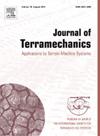An insight into mobility power efficiency of an automated guided vehicle performing in the presence of a hinged trailer
IF 3.7
3区 工程技术
Q3 ENGINEERING, ENVIRONMENTAL
引用次数: 0
Abstract
This is the first research that it conceptually appraises new technical paradigm (mobility power efficiency) for automated guided vehicle (AGV) of tandem robotic transportation system. Pulling operations were conducted based on changes of operational parameters of the AGV speed, tire air pressure, and trailer load. Results of the operations for the mobility power efficiency (5.54–28.67 %) were compared to those of former technical paradigm (tractive power efficiency). Reliable data obtained from exponential model indicated that the AGV slippage values for the maximum mobility power efficiency were higher (averagely 3.1 times) than those of the maximum tractive power efficiency. As traction ability of the AGV in the pulling operations is more important than its mobility ability, the tractive power efficiency must be considered as main technical paradigm. The mobility power efficiency must be considered as main technical paradigm for free motion of the AGV without drawbar pull. Meanwhile, mobility power loss values indicated that 1.19–33.52 % of the AGV mobility power were wasted. These research results are advantageous for researchers, engineers, and supervisors concerned with the AGV not only operated in inside and outside robotic production lines of manufacturing sectors, but also employed in intelligent warehousing systems and wharf container terminals.
在铰接拖车存在的情况下,对自动引导车辆的移动动力效率的洞察
本文首次从概念上评价串联机器人运输系统中自动导引车(AGV)的新技术范式(移动动力效率)。根据AGV速度、轮胎气压、拖车载荷等运行参数的变化进行牵引操作。将机动动力效率(5.54 ~ 28.67%)与原有技术范式(牵引动力效率)的操作结果进行比较。从指数模型得到的可靠数据表明,最大移动动力效率下的AGV滑移值比最大牵引动力效率下的AGV滑移值高(平均为3.1倍)。由于AGV在牵引作业中的牵引能力比其机动能力更重要,因此必须以牵引功率效率为主要技术范式。移动动力效率是AGV实现无牵引力自由运动的主要技术指标。同时,移动功率损失值表明,AGV移动功率浪费了1.19 ~ 33.52%。这些研究成果对研究AGV的研究人员、工程师和管理人员都是有利的,AGV不仅可以应用于制造业的内外机器人生产线,还可以应用于智能仓储系统和码头集装箱码头。
本文章由计算机程序翻译,如有差异,请以英文原文为准。
求助全文
约1分钟内获得全文
求助全文
来源期刊

Journal of Terramechanics
工程技术-工程:环境
CiteScore
5.90
自引率
8.30%
发文量
33
审稿时长
15.3 weeks
期刊介绍:
The Journal of Terramechanics is primarily devoted to scientific articles concerned with research, design, and equipment utilization in the field of terramechanics.
The Journal of Terramechanics is the leading international journal serving the multidisciplinary global off-road vehicle and soil working machinery industries, and related user community, governmental agencies and universities.
The Journal of Terramechanics provides a forum for those involved in research, development, design, innovation, testing, application and utilization of off-road vehicles and soil working machinery, and their sub-systems and components. The Journal presents a cross-section of technical papers, reviews, comments and discussions, and serves as a medium for recording recent progress in the field.
 求助内容:
求助内容: 应助结果提醒方式:
应助结果提醒方式:


